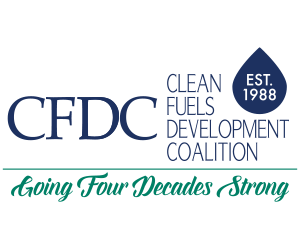CFDC News & Events
Get More Ethanol Into Gasoline!
Speaking before the Advanced Bioeconomy Leadership Conference in Washington, D.C, today, Clean Fuels Development Coalition (CFDC) Executive Director Doug Durante said his primary objective for the year was simply to get more ethanol into gasoline.
“We just spent four years where the metric of value was carbon reduction, and now we are being told by the White House and Republican Congress they don’t care about that anymore. So, if the emphasis is on domestic energy and economic development, ethanol still brings that to the table and in so doing save American agriculture from what could be a true crisis.”
We can make a high octane E30 fuel using today’s blendstock and provide a premium grade at regular unleaded prices, resulting in substantial savings to consumers and creating demand for billions of bushels new corn demand.”
Message From Brussels: Value Proposition for Ethanol’s Octane Dwarfs SAF, Marine Markets
Speaking before the World Ethanol and Biofuels Conference in Brussels, Belgium last week, the Clean Fuels Development Coalition’s Doug Durante said Aviation and Marine Applications may be future market opportunities, but the gasoline market presents the greatest untapped potential to expand ethanol demand.
Durante told delegates that the highest value and the highest return for ethanol is to provide clean, low carbon octane for the growing premium market and at current volumes we are only scratching the surface.
Where will the Reductions Come From? High Octane BioEthanol to the Rescue
July 5, 2024: A recent Rule by the U.S. EPA that relies on electric vehicles to reduce pollution is unlikely to succeed, according to CFDC’ Doug Durante writing in the Biofuels Digest. Where Will the Reductions Come From notes the 14 million vehicles sold in 2023 and the 270 million vehicles on the road today running on gasoline can add much higher blends of ethanol to increase efficiency and reduce harmful emissions. Citing work from the Department of Energy, moving to 20% ethanol blends and beyond would provide substantial benefits. For more on this story and links to several other Durante Articles click here.
New Issue Brief on Next Generation Fuels Act
October 1, 2023: CFDC has produced an Issue Brief clearly explaining the provisions of the Next Gen legislation and makes a compelling case for its passage.
The new brief, the latest in CFDC’s highly successful Issue Brief and White Paper series, illustrates how this bill would open the market for higher ethanol blends that reduce carbon emissions, lower gasoline prices, reduce imports of foreign oil, and stimulate multiple sectors of the economy.
World Ethanol and Biofuels Conference
CFDC is once again a proud supporting organization for the World Ethanol and Biofuels Conference in Brussels, Belgium on November 5–7, 2024. CFDC Executive Doug Durante serves as one of the co-chairs of the conference and said “For 25 years this prestigious event brings together ethanol and biofuel stakeholders from more than 50 countries. We consider this conference to be the premier international event of its kind and have found it to be invaluable”.
New Issue Brief Challenges the EV Vision
Biofuels and a Technology Neutral Strategy the Better Approach
The widespread introduction of electric vehicles as a means of reducing carbon emissions presents a far greater challenge than the public is being led to believe, according to new research by the Clean Fuels Development Coalition (CFDC).
This conclusion is presented in Reality EV: No Silver Bullet, a new Issue Brief released here this week. Reality EV’s research explains the consumer/taxpayer, infrastructure, and environmental constraints single fuel source electric vehicles (EVs) must overcome to live up to their often-claimed perfect solution. In addition, it is estimated that a $2-3 trillion dollar government/taxpayer investment is needed for EVs to replace 50% of the consumer fleet.
CFDC Executive Director Doug Durante said this research is not intended to dismiss the potential contribution of EVs but rather to put them in perspective. “EVs will clearly be a key part of our transportation mix but the reality of cost, consumer choice, re-charging, and many other factors indicates we need to make sure biofuels remain part of the mix,” said Durante. “Increasing the octane of gasoline with clean burning ethanol allows for automakers to produce much more efficient vehicles that can provide health and climate benefits now, not decades from now.”
For the full press release and access to the Brief,
CFDC Comments on EPA Multipollutant Rule
An over reliance on electric vehicles, and failure to correct models and testing procedures plague the rule proposed by EPA that may fall well short of predicted benefits.
Ethanol’s Clean Octane Key to EPA Particulate Rule
Coalition Urges Administrator to Address Mobile Sources
September 6, 2022: In a detailed letter to the U.S. Environmental Protection Agency, the Clean Fuels Development Coalition (CFDC) called on the agency to use its existing authority to reduce toxic aromatics in gasoline as required by the Clean Air Act.
A pending rule to reduce fine particulate matter (pm) must include mobile source controls and address benzene and related toxics, according to CFDC. The letter notes that EPA in its report to Congress in 2011 acknowledged the serious health impacts of particulates and the relationship between aromatic compounds like benzene and fine pm emissions.
New White Paper Says The Real Cost of Gasoline …is to Our Health
May 15, 2022: A new White Paper from the Clean Fuels Development Coalition rings the alarm that EPA continues to miss opportunities to replace toxic aromatic compounds with clean burning ethanol and the agency could save thousands of lives through reduced particulate emissions in the air we breathe.
Fuel Economy Rule Needs High Octane
August 30, 2021: A wide range of stakeholders responded strongly to a proposed rule-making to tighten vehicle emissions by applauding the action but warning of near term health risks that must be addressed in the final rule.
Several organizations and individuals from the ethanol, auto, and climate sectors joined CFDC to tell the U.S. Environmental Protection Agency (EPA) that the failure to adopt a strategy and pathway to higher octane low carbon fuels will result in the 270 million cars on the road today continuing to emit not just greenhouse gases but also highly toxic particulates.
Click below for more information and links to comments.

Durante and Governor Ben Nelson of Nebraska.
